Viewing Rosa Parks
by Jo Freeman
Published on Senior Women Web on November 2, 2005
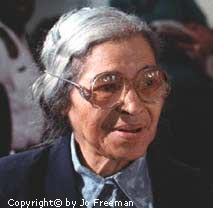
In Hindi it's called "Darshan" -- the viewing of a saint or a saintly person, dead or alive. When I heard that Rosa Parks, who had died in Detroit on October 24 and would be buried there, would be the first woman to lie in honor in the Capitol Rotunda, I had to go pay my respects.
So did my friend, Liz Cox. We had heard and read about the bus boycott in Montgomery, Alabama as children. It began early in December of 1955 after Rosa Parks refused to give up her seat on a Montgomery bus to a white man. All other seats in the bus were occupied. It lasted through December of 1956, after the Supreme Court had affirmed a lower court decision declaring that Alabama's laws requiring segregation on buses were unconstitutional.
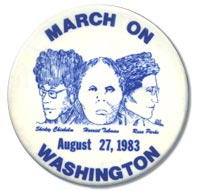 I was ten in December of 1955; Liz was 16. I grew up in Los Angeles; Liz in Port Arthur, Texas. I don't remember much about December 1955, but I do remember that the Montgomery bus boycott became a regular topic of conversation with my mother throughout 1956. Born and raised in northern Alabama, she had gotten right on race, and made it clear that she thought the South was wrong and had to change its ways.
I was ten in December of 1955; Liz was 16. I grew up in Los Angeles; Liz in Port Arthur, Texas. I don't remember much about December 1955, but I do remember that the Montgomery bus boycott became a regular topic of conversation with my mother throughout 1956. Born and raised in northern Alabama, she had gotten right on race, and made it clear that she thought the South was wrong and had to change its ways.
The attitude of Liz's family was still rooted in Southern sensibilities. They knew that the year-long refusal of Montgomery blacks was opening Pandora's box, but they didn't like it. Liz was the rebel in her family, the one who said "it's about time."
Desegregation was a long time coming. During the late 19th Century there was a movement for white supremacy. What had been a somewhat fluid system of rules about race and place was hardened into law, with criminal penalties — or worse — for breaking them. The NAACP was founded in 1909 to combat these laws. As secretary of the Montgomery chapter, Parks wrote and typed numerous letters objecting to the treatment of blacks by white public officials and public employees.
Parks was the third Montgomery woman in 1955 to refuse to give up her seat on a city bus, but the first that E.D. Nixon, former head of the local NAACP, thought was the right symbol for a legal challenge. Middle-aged, quiet, respectable, and pleasant, Parks was not susceptible to the character assassination that Nixon knew would come. Nonetheless, by the time the boycott ended she had become such a symbol of black resistance that her life was threatened and she could no longer find work in Montgomery. In 1957 she and her husband moved to Detroit, where they made a life for themselves for almost fifty years.
After John Conyers Jr. became a Member of Congress in 1965 (D. MI) he hired her in his District office, but left her plenty of time to travel and speak as the respected mother of the civil rights movement. I met and photographed her at a 1988 conference on women and the civil rights movement held in Atlanta. She bore her celebrity stoically, the same way she had gone to jail in 1955. It wasn't what she wanted, but if it served the cause, she would put up with it.
Liz and I met at 5:00 p.m. in front of the American Indian Museum. The procession carrying the casket had landed at Baltimore's Thurgood Marshall airport. DC was the second stop on a three city tour of Parks' remains. Southwest airlines had made available a jet with an all black flight crew to take her to Montgomery for one memorial service, and to return her to Detroit the following day for another. After a Capitol ceremony, she was scheduled to lie in state until midnight on Sunday, October 30, and from 7:00 a.m. until 10:00 a.m. on Monday. Even in death Parks was still a traveling ambassador for civil rights.
As darkness gathered, we watched the west lawn of the Capitol fill with people, while those of us hanging out on 3rd St. waited for the hearse. It finally arrived at 7:30, followed by a decorated DC metrobus to symbolize Parks' action, and whisked down the street. I took one photograph; even though I jogged down the street in pursuit, the procession never stopped long enough for me to get another one.
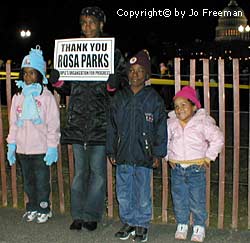 On the way back, Liz spotted two men carrying printed signs that said "Thank you Rosa Parks." We asked to take their photo and did so with the Capitol dome glowing in the background. Soon a small crowd of people was passing the signs around while their friends and family took photos memorializing the moment. We debated joining the lines waiting to view the casket, but knew that there were too many people to get through before closing. Women, some with children in tow, appeared to be about two-thirds of those waiting to honor Rosa Parks.
On the way back, Liz spotted two men carrying printed signs that said "Thank you Rosa Parks." We asked to take their photo and did so with the Capitol dome glowing in the background. Soon a small crowd of people was passing the signs around while their friends and family took photos memorializing the moment. We debated joining the lines waiting to view the casket, but knew that there were too many people to get through before closing. Women, some with children in tow, appeared to be about two-thirds of those waiting to honor Rosa Parks.
We returned at 6:00 the next morning. As the sky turned pink we threaded through the maze of ropes and fences up Capitol Hill to the security tent. Once there we found that the line waiting to be searched was rather short. The Capitol police had decided to let mourners come through all night long. Instead of entering the Capitol at 7:00 a.m., we were out by then.
The casket sat solemnly in the middle of the Rotunda, with an honor guard at both ends. Around the perimeter were several statues -- the semi-permanent residents of the Rotunda. Across from where we stood were the black bars of the press risers, left from the previous evening's ceremony. As we stood quietly with a few dozen others and paid our respects, we could see the statue of the three suffragists peering at Rosa Parks from behind the bars. Sculpted by Adelaide Johnson, this statue was donated to the federal government in a ceremony at the Captol 1921. It was then relegated to the basement until feminist protest raised it up in 1997. It was fitting that the first woman to lie in honor should be watched over by three of her forebears in the fight for civil rights.
My first attempt to take a photograph of the casket was thwarted by a Capitol Hill policeman, who told me that photos were prohibited inside the Capitol. So was my last attempt. But in between....
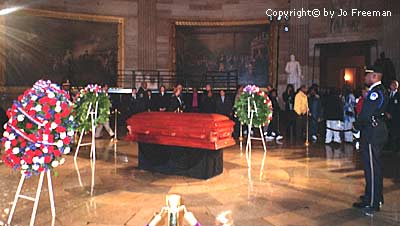
Today's small camera phones and digital cameras make a mockery of such a prohibition. From the flashing lights and the raised cell phones, it was obvious that we weren't the only ones carrying cameras. We just had to be a little less obvious about using them.
Once outside we parted. Liz had had enough Darshan. I wanted more.
I found it at the Metropolitan AME Church. AME stands for African Methodist Episcopal. The oldest of the black denominations, it was founded shortly after the American Revolution by former slaves who did not like being treated like poor relations in the House of God.
This was Rosa Park's religious home in Montgomery and Detroit; the "National Cathedral of African Methodism" was the right place in D.C. to celebrate her life.
The service was scheduled for 1:00. I came late because I knew I wouldn't get in and I can stand immobile in a crowd for only so long. There were about 200 people outside, flanking the entranceway and across the street. The hearse was parked out front, and a large picture of Parks was off to one side. The church had thoughtfully provided speakers so we could hear the service and the many tributes from famous people. By the time these left and the casket was brought to the door, my knees were so stiff it hurt to move. But move I did, as soon as the police looked the other way.
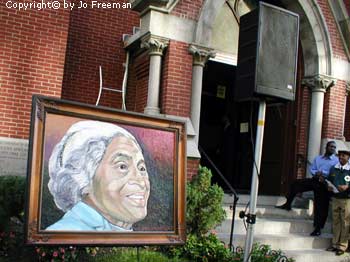
The D.C. police were mellow until about half an hour before the end, when they became rather heavy handed for a small crowd that had come to view and not to protest. By the time I made it near the back of the hearse, the casket had been put inside and the door closed.. As I tried to photograph the back, an officer stepped in front of my camera. When I asked him to step aside just long enough for me take a photo, he only smirked. I don't think Rosa Parks would have approved of his attitude or his action.
The speakers in the church rightly extolled her fortitude and her courage, but Rosa Parks knew well how long and how hard people had worked to make that boycott possible. E.D. Nixon had only envisioned a legal challenge. But the women of the Women's Political Council, most of them professors at Alabama State College, had been planning a bus boycott for some time. Professor Jo Ann Robinson had never forgotten her humiliation by a white bus driver when she arrived in Montgomery to teach in 1949; many others nursed bitter memories of their own experiences with abusive drivers personally interpreting and enforcing the segregation laws.
The WPC had repeatedly asked that these practices be curtailed. In May of 1954 Robinson had written the mayor of Montgomery that several organizations were thinking of boycotting the busses. As soon as they learned about Parks' arrest, the women of the WPC stayed up all night to produce and distribute flyers telling the black population of Montgomery to stay off the busses.
What began as a one day protest was so successful that it lasted 13 months, until the city complied with the Supreme Court's ruling. It catapulted the young minister of Dexter Avenue Baptist Church, Martin Luther King, Jr., into a nationally known public figure. He was chosen to be the boycott spokesman largely because he was so new to town that he was not part of any faction and hadn't made any enemies. It raised consciousness about segregation and put civil rights on the national agenda, talked about everywhere. It changed the direction of many young lives.
In 1956, Liz's high school civics class held a mock Presidential election. When both of the "parties" wrote platforms supporting segregation, Liz and three classmates (all girls) formed a third party specifically to challenge that plank. The debate kept her class in turmoil for months.
In 1957, my mother and I drove to Alabama to spend Christmas with her family. After two years of reading and talking about desegregation, I was primed. When a tour of the newly renovated county courthouse disclosed restrooms segregated by race as well as sex, I confronted my grandmother. She had an important job in that courthouse so to my 12-year-old mind, she should have prevented this travesty. As we argued about segregation, the aunts, the uncles and the cousins gathered in the parlor. I spoke from one side of the room; they stood on the other. In between us, off to the side, my mother watched the debate without interfering. I interpreted her silence as approval. Thus was launched my career as a civil rights activist.
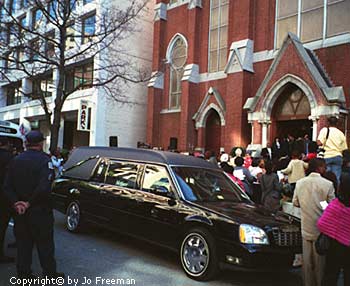
Saying goodbye to Rosa Parks
Copyright © 2005 by Jo Freeman. Some of Jo's early civil rights activism is described in her most recent book At Berkeley in the Sixties: Education of an Activist (Indiana U. Press 2004).
Books by Jo | What's New | About Jo | Photos | Political Buttons
Home | Search | Links | Contact Jo | Articles by Jo